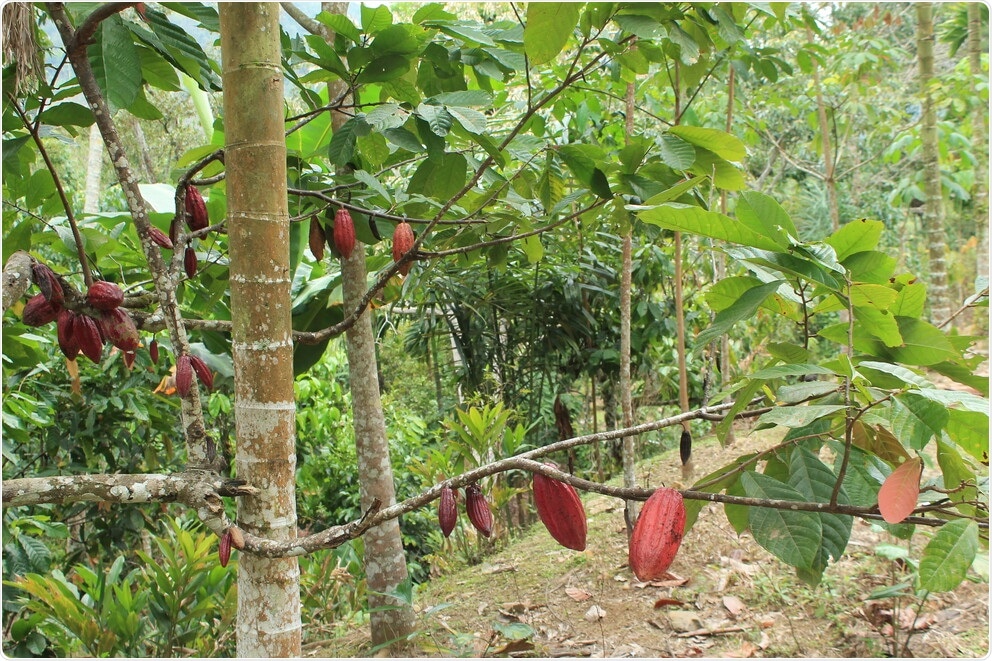A comprehensive and meticulous comparison of the genomes of multiple strains of the cacao tree by a group of scientists has offered insights into the role genomic structural variants play in the regulation of gene expression and chromosome evolution, giving rise to the variations within populations of the plant.

The genomes of different populations of cacao trees like these are 99.9% identical, but it is the structural variants in that one-tenth of 1% of their genomes that accounts for the plant’s diversity in different regions and its adaptation to climate and various diseases. Image Credit: Robert Wilson.
The study has implications for plant genetics in general and will not have been possible without the powerful computers that made the high-resolution sequencing of genomes possible, quicker, and cost-effective, according to researcher Mark Guiltinan, J. Franklin Styer Professor of Horticultural Botany, and professor of plant molecular biology in Penn State’s College of Agricultural Sciences.
The genomes of different populations of cacao trees are 99.9% identical, but it’s the structural variants in that one-tenth of 1% of their genomes that accounts for the plant’s diversity in different regions and its adaptation to climate and various diseases. This study makes an association between structural variation and the ability of a plant to adapt to a local environment.”
Mark Guiltinan, J. Franklin Styer Professor, Horticultural Botany, College of Agricultural Sciences, The Pennsylvania State University
For more than a decade, molecular geneticists are aware that genomic structural variants can play vital roles in the adaptation and speciation of both animals and plants; however, their overall impact on the fitness of plant populations is not known much. This was partially because accurate population-level identification of structural variants needs analysis of multiple high-quality genome assemblies, which are not widely available.
In the current research, scientists examined the fitness consequences of genomic structural variants in natural populations by examining and comparing chromosome-scale genome assemblies of 31 naturally occurring populations of Theobroma cacao, the long-lived tree species that is the source of chocolate. Of those 31 strains of cacao, they identified more than 160,000 structural variants.
The scientists identified that a majority of the structural variants are deleterious and thus constrain the adaptation of the cacao plant. These detrimental effects likely emerge as a direct result of impaired gene function and as an indirect result of suppressed gene recombination over extended periods. The results of the research were published on August 16th, 2021, in the Proceedings of the National Academy of Sciences journal.
In spite of the overall detrimental effects, the research also discovered individual structural variants bearing signatures of local adaptation, most of which are linked with genes differentially expressed between populations. Genes involved in pathogen resistance are among these candidates, pinpointing the contribution of structural variants to this vital local adaptation trait.
In general, the results offer important insight into processes underlying the fitness effects of structural variants in natural populations, the scientists pointed out. They indicate that structural variants influence gene expression, which probably impairs gene function and contributes to their detrimental effects.
The researchers also offered empirical support for a theoretical prediction that structural variants result in the suppression of gene recombination, making it less probable that plants can adapt to stressors.
Besides unveiling new empirical evidence for the evolutionary importance of structural variants in all plants, documenting the structural variants and genomic differences in the 31 strains of cacao offers a useful resource for current genetic and breeding studies for that valuable plant, Guiltinan added.
All cacao comes from the Amazon basin—plants were collected a long time ago from the wild by collectors and they were cloned, so we have a permanent collection. Their genomes have been sequenced, and that represents a huge amount of work and data. As a result of this study, we know that structural variation is important to the survival of the plant, to the evolution of the plant, and especially to the adaptation of the plant to local conditions.”
Mark Guiltinan, J. Franklin Styer Professor, Horticultural Botany, College of Agricultural Sciences, The Pennsylvania State University